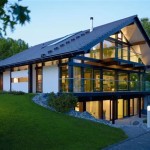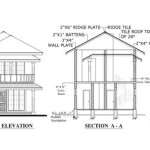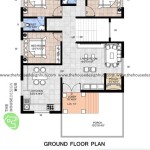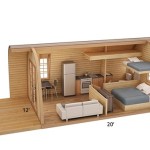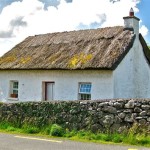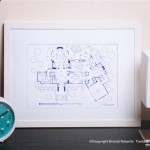Dogtrot House Plan: A Timeless Design for Southern Living
In the realm of American architecture, few designs embody the essence of Southern charm and functionality quite like the dogtrot house plan. This distinctive style, with its open breezeway connecting two separate structures, has stood the test of time, offering a wealth of benefits that make it an enduring choice for those seeking comfort, efficiency, and a connection to history. ### Origins and History of Dogtrot House Plans The dogtrot house plan originated in the rural South during the 18th century, borne out of necessity and the unique climatic conditions of the region. The design evolved from simple log cabins, where a central breezeway was added to provide relief from the sweltering heat and humidity. This ingenious solution allowed for air to circulate freely between the two structures, creating a cooler and more comfortable living environment. ### Distinctive Features of Dogtrot House Plans 1.Open Breezeway:
The defining characteristic of a dogtrot house plan is the open breezeway or dogtrot, which separates the main living quarters from the kitchen and other service areas. This breezeway acts as a central artery, connecting the two structures and serving as a gathering space, a dining area, or even a work area. 2.Separate Structures:
Dogtrot houses typically consist of two separate structures, connected by the breezeway. The main living quarters, known as the "big house," usually includes bedrooms, a living room, and a dining room. The smaller structure, often referred to as the "kitchen house," houses the kitchen, pantry, and sometimes additional bedrooms or storage space. 3.Porches and Verandas:
Dogtrot house plans often feature extensive porches and verandas, wrapping around the main house and the kitchen house. These outdoor spaces provide shade, extend the living area, and serve as ideal spots for relaxing, entertaining guests, or simply enjoying the surrounding landscape. ### Advantages of Dogtrot House Plans 1.Climate Control:
The open breezeway is a key factor in the climate control benefits of dogtrot house plans. The airflow between the two structures helps regulate indoor temperatures, keeping them cooler in the summer and warmer in the winter. This natural ventilation reduces reliance on mechanical cooling and heating systems, resulting in energy savings. 2.Privacy and Flexibility:
The separation of the main living quarters from the kitchen and service areas provides a sense of privacy, keeping cooking odors and noise away from the sleeping and living spaces. This layout also offers flexibility in terms of space allocation and can easily adapt to changing family needs. 3.Connection to the Outdoors:
The abundance of porches and verandas in dogtrot house plans blurs the lines between indoor and outdoor living. These outdoor spaces invite residents to enjoy fresh air, natural light, and the beauty of their surroundings. 4.Historical and Cultural Significance:
Dogtrot house plans hold historical and cultural significance, particularly in the Southern United States. They represent a tangible connection to the region's past and are often associated with traditional Southern values, such as hospitality, family, and a strong sense of community. ### Modern Interpretations of Dogtrot House Plans While the essence of the dogtrot house plan remains rooted in its historical origins, modern interpretations have emerged to cater to contemporary lifestyles and preferences. These adaptations often incorporate modern materials, amenities, and design elements while preserving the core principles of the traditional dogtrot design. 1.Open Floor Plans:
Modern dogtrot house plans often feature open floor plans within the main living quarters and kitchen house, creating a more spacious and cohesive living environment. 2.Updated Materials:
Contemporary dogtrot houses may utilize a variety of materials, including brick, stone, and metal, along with traditional wood, offering a wider range of aesthetic options. 3.Energy-Efficient Features:
Modern dogtrot house plans often incorporate energy-efficient features, such as double-paned windows, insulated walls, and energy-star appliances, to reduce energy consumption and increase sustainability. 4.Customization and Personalization:
Modern interpretations allow for extensive customization, enabling homeowners to tailor the design to their specific needs and preferences, including the size, layout, and amenities of the house. In conclusion, the dogtrot house plan is a remarkable piece of architectural heritage that continues to inspire and captivate homeowners in the 21st century. With its open breezeway, separate structures, porches, and verandas, this timeless design offers a unique blend of comfort, functionality, and a connection to the outdoors. Whether in its traditional or modern interpretation, the dogtrot house plan embodies the essence of Southern living, making it an enduring choice for those seeking a harmonious balance between history, comfort, and contemporary style.
Dog Trot House Plan Dogtrot Home By Max Fulbright Designs

Experience The Charm Of Our Camp Creek Dog Trot House Plan

3 Bedroom Dogtrot House Plan 92318mx Architectural Designs Plans

Mid Century Modern Dogtrot House Plan With 4 Beds And 3 Baths 623172dj Architectural Designs Plans

Dog Trot House Plan Dogtrot Home By Max Fulbright Designs

Diana S Dog Trot Dogtrot Cabin Floor Plan House Plans

Dog Trot House Plan Dogtrot Home By Max Fulbright Designs
Dogtrot House Wikipedia

Dogtrot House Plan Large Breathtaking Dog Trot Style Floor Plans

Dog Trot House By Max Fulbright Designs

